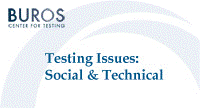Buros-Nebraska Series on Measurement and Testing

Social and Technical Issues in Testing: Implications for Test Construction and Usage
Date of this Version
1984
Document Type
Article
Citation
Published in Social and Technical Issues in Testing: Implications for Test Construction and Usage, edited by Barbara S. Plake (Hillsdale, NJ: Lawrence Erlbaum Associates, 1984).
Abstract
It was the Chinese over 3000 years ago, not the Americans in this century, who first used large-scale psychological testing (Dubois, 1966). But, as with many other technological developments, it was the United States that enthusiastically adopted the method (Haney, 1981). By now it is highly probable that every person in our country has been affected in some way by the administration of tests. Testing has become the means by which major decisions about people's lives are made in industry, education, hospitals, mental health clinics, and the civil service.
Tests themselves, by and large, are facially neutral. They do not inherently discriminate against those who take them and, undoubtedly, scores derived from tests have been used to admit, advance, and employ. For most people, however, test results have served as exclusionary mechanisms- to segregate, institutionalize, track, and deny access to coveted and increasingly scarce employment opportunities.
At one time, the work of academic and applied psychometricians went virtually unexamined by the law, but as the use of tests increased in the United States, so did their potential for causing legally cognizable injury to test takers. As a result, there is probably no current activity performed by psychologists so closely scrutinized and regulated by the legal system as testing.


Comments
Copyright © 1984 by Lawrence Erlbaum Associates. Digital edition copyright © 2012 Buros Center for Testing. This book may be downloaded, saved, and printed by an individual for their own use. No part of this book may be re-published, re-posted, or redistributed without written permission of the holder of copyright.